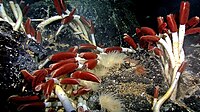
Photo from wikipedia
The present study details the effects of basin-scale hydrographic characteristics of the Red Sea on the macroecology of Chaetognatha, a major plankton component in the pelagic realm. The hydrographic attributes… Click to show full abstract
The present study details the effects of basin-scale hydrographic characteristics of the Red Sea on the macroecology of Chaetognatha, a major plankton component in the pelagic realm. The hydrographic attributes and circulation of the Red Sea as a result of its limited connection with the northern Indian Ocean make it a unique ecohydrographic region in the world ocean. Here, we aimed to identify the prime determinants governing the community structure and vertical distribution of the Cheatognatha in this ecologically significant world ocean basin. The intrusion of Gulf of Aden Water influenced the Chaetognatha community composition in the south, whereas the overturning circulation altered their vertical distribution in the north. The existence of hypoxic waters (< 100 µmol kg−1) at mid-depth also influenced their vertical distribution. The detailed evaluation of the responses of the different life stages of Chaetognatha revealed an increased susceptibility of adult individuals to hypoxic waters compared to immature stages. Higher oxygen demands of the adults for the egg and sperm production might have prevented them from inhabiting the oxygen-deficient mid-depth zones. The carbon and nitrogen content of the Copepoda and Chaetognatha communities and the quantification of the predation impact of Chaetognatha on Copepoda based on the feeding rate helped in corroborating the significant trophic link between these two prey–predator taxa. The observed influences of physical and chemical attributes on the distribution of Chaetognatha can be used as a model example for the role of the hydrography on the zooplankton community of the Red Sea.
Journal Title: Marine Biology
Year Published: 2019
Link to full text (if available)
Share on Social Media: Sign Up to like & get
recommendations!